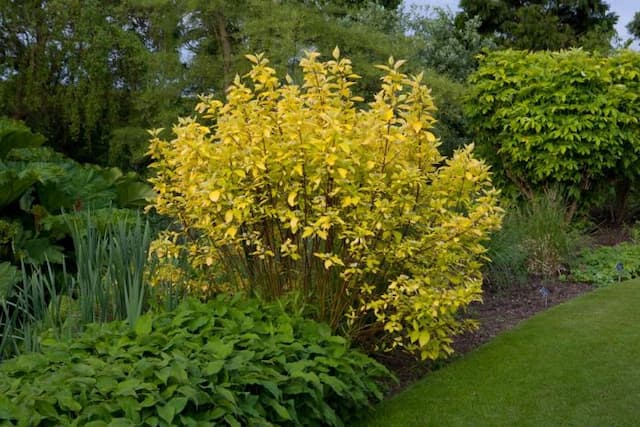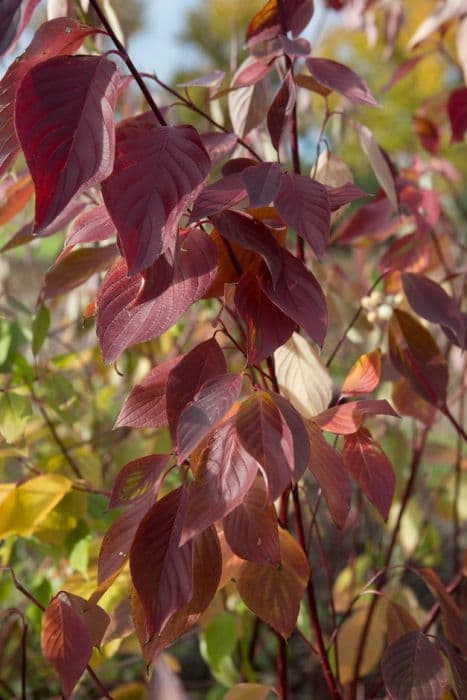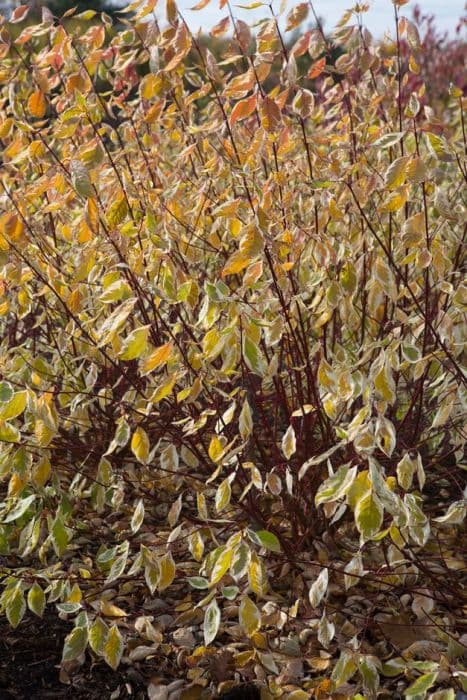Variegated Cornelian Cherry Dogwood Cornus mas 'Variegata' (v)











ABOUT
Cornelian cherry 'Variegata' is an ornamental plant renowned for its striking variegated foliage. Each leaf displays a blend of green with creamy white to yellow margins, creating a stunning mosaic of color that can brighten up any garden. During the spring, this plant comes alive with showy, small yellow flowers that are arranged in dense clusters. These blooms stand out beautifully against the variegated leaves, providing a cheerful display. After the flowering period, the Cornelian cherry 'Variegata' bears fruits that are olive-shaped, starting out as a glossy green and gradually ripening to a cherry-like red. These fruits can add visual interest to the plant throughout the summer and into autumn. In addition to its attractive foliage and fruit, the Cornelian cherry 'Variegata' also features textured bark that exfoliates with age, revealing a mottled pattern of underbark that adds to its charm, especially in the winter months. Overall, its combination of decorative leaves, flowers, fruit, and bark makes it a multifaceted plant that provides year-round interest.
About this plant
 Names
NamesFamily
Cornaceae.
Synonyms
Variegated Cornelian Cherry Dogwood.
Common names
Cornus mas 'Variegata'
 Toxicity
ToxicityTo humans
Cornelian cherry is generally considered non-toxic to humans. The fruit is edible and often used in various culinary dishes and preserves. However, like many plants, other parts of the Cornelian cherry, such as the bark and leaves, might cause mild stomach upset if ingested in large quantities due to the presence of saponins and other compounds. It is not commonly associated with serious poisoning or severe symptoms in humans.
To pets
Cornelian cherry is also considered non-toxic to pets. The fruit is not harmful to dogs or cats if consumed. However, as with humans, ingesting other parts of the plant, such as leaves or bark, in significant amounts might result in mild gastrointestinal upset for pets. This can include symptoms like vomiting or diarrhea. Serious toxicity is uncommon, and the Cornelian cherry is not listed among the plants that are a high risk of poisoning to pets.
 Characteristics
CharacteristicsLife cycle
Perennials
Foliage type
Deciduous
Color of leaves
Variegated
Flower color
Yellow
Height
15 feet (4.572 meters)
Spread
15 feet (4.572 meters)
Plant type
Shrub
Hardiness zones
5
Native area
Europe
Benefits
 General Benefits
General Benefits- Ornamental Appeal: Cornus mas 'Variegata' offers year-round visual interest with its variegated foliage, bright yellow flowers, and decorative fruit.
- Landscape Versatility: It can be used in a variety of landscape designs, including as a focal point, hedge, or part of a mixed border.
- Wildlife Attraction: The plant provides food for birds and other wildlife with its edible fruit.
- Drought Tolerance: Once established, it has a good tolerance for drought, making it suitable for xeriscaping and reducing the need for watering.
- Low Maintenance: It generally requires less pruning and care compared to some other ornamental shrubs, saving time and effort for the gardener.
- Cold Hardiness: Being resistant to cold temperatures, it can survive and thrive in cooler climates without special protection.
- Seasonal Interest: The plant adds interest throughout the seasons with its changing leaf color in fall and persistent fruit in winter.
 Medical Properties
Medical PropertiesThis plant is not used for medical purposes.
 Air-purifying Qualities
Air-purifying QualitiesThis plant is not specifically known for air purifying qualities.
 Other Uses
Other Uses- Cornelian cherry 'Variegata' can be used as a natural dye, producing a range of yellow, green, or brown hues, depending on the mordant used.
- The wood of Cornelian cherry 'Variegata' is dense and can be utilized for tool handles or woodworking projects requiring durability.
- Due to its dense canopy, the plant can serve as a privacy screen or windbreak in a landscaped garden.
- The flowers of the Cornelian cherry 'Variegata' provide nectar for early spring pollinators such as bees when other food sources are scarce.
- The leaves of the Cornelian cherry 'Variegata' can be used in composting to add nutrients and organic matter.
- In landscape design, the plant is used for its variegated leaves to create contrasting textures and colors in a garden setting.
- The Cornelian cherry 'Variegata' can be trained into a small tree or shrub form, offering versatility in topiary art.
- The plant can serve as a host for certain species of butterflies and moths, contributing to local biodiversity.
- Due to its hardy nature, Cornelian cherry 'Variegata' can be used in urban planting schemes to enhance the green infrastructure in cities.
- The early blossoming nature of Cornelian cherry 'Variegata' can be a valuable source of winter color in a landscape, adding aesthetic value during the colder months.
Interesting Facts
 Feng Shui
Feng ShuiThe Variegated Cornelian Cherry is not used in Feng Shui practice.
 Zodiac Sign Compitability
Zodiac Sign CompitabilityThe Variegated Cornelian Cherry is not used in astrology practice.
 Plant Symbolism
Plant Symbolism- Protection: Cornus mas, commonly referred to as Cornelian Cherry, is sometimes associated with protection due to its hard wood and the fact that it was used in the past to make weapons and tools.
- Good Fortune and Durability: The Cornelian Cherry blossoms early in the spring, symbolizing the end of winter and the promise of a fruitful year ahead, thus embodying good fortune and the durability to withstand harsh conditions.
- Sturdiness and Resilience: The plant’s ability to adapt to different soils and climates makes it a symbol of sturdiness and resilience, qualities admired in various cultures.
- Purity and Fresh Start: With its bright early blooms, the Cornelian Cherry signifies purity and a fresh start, often related to the New Year or new beginnings.
 Water
WaterThe Variegated Cornelian Cherry Dogwood should be watered deeply once a week during its growing season, ensuring that moisture reaches the deeper roots. The soil should be allowed to dry out slightly between waterings. During dry spells or hot weather, additional water may be necessary, potentially increasing to twice a week. As a general rule, provide about 1-2 gallons per watering for young plants, increasing to 2-4 gallons for mature trees. In the cooler dormant season, reduce watering frequency to every two to three weeks or as needed, depending on soil moisture levels.
 Light
LightThe Variegated Cornelian Cherry Dogwood benefits from full sun to partial shade. Ideally, the plant should receive at least four hours of direct sun daily for optimal flowering and variegation. A location that offers morning sun and afternoon shade would be particularly ideal, especially in areas with very hot summers, to prevent leaf scorch.
 Temperature
TemperatureThe Variegated Cornelian Cherry Dogwood can tolerate a range of temperatures and is hardy in USDA zones 4 through 8. This means it can handle minimum temperatures as low as -20 to -30°F and it thrives in areas where the average temperature falls between 60°F and 70°F during the growing season. It is a resilient plant that will survive winters well and does not require special temperature considerations outside of its hardiness range.
 Pruning
PruningPrune the Variegated Cornelian Cherry Dogwood to maintain shape and encourage healthy growth, best done in late winter or early spring before new growth starts. Remove any dead, damaged or crossing branches, and thin out the canopy if necessary to allow light and air to reach the inner branches. Routine pruning is usually performed every 1 to 3 years, depending on the tree's growth and desired shape. Prune immediately after flowering if you wish to avoid cutting off next year's flower buds.
 Cleaning
CleaningAs needed
 Soil
SoilVariegated Cornelian Cherry requires well-draining soil with a pH range of 5.5 to 7.5. A good mix would consist of loamy garden soil, compost, and sand or perlite to improve drainage. Amending with organic matter is beneficial for nourishment.
 Repotting
RepottingVariegated Cornelian Cherry trees are typically planted in the ground and do not require frequent repotting. If grown in a container, repotting every 2-3 years or when rootbound is advisable.
 Humidity & Misting
Humidity & MistingVariegated Cornelian Cherry is adaptable to a wide range of humidity levels and does not require specific humidity conditions for optimal growth.
 Suitable locations
Suitable locationsIndoor
Ensure bright light, water regularly, protect from drafts.
Outdoor
Full sun to part shade, protect from strong winds, mulch root zone.
Hardiness zone
4-8 USDA
 Life cycle
Life cycleCornelian cherry 'Variegata' (Cornus mas 'Variegata') begins its life cycle as a seed, typically germinating in spring when soil temperatures warm up. Initial growth is seen as the seed develops into a seedling with a root system and a shoot bearing simple leaves. As the plant matures, it enters a vegetative stage where it grows more complex variegated leaves and a branching woody structure over several years. Between late winter and early spring, Cornelian cherry 'Variegata' reaches the flowering stage, producing small yellow blossoms before the leaves fully emerge. After pollination, the flowers develop into bright red, cherry-like fruits in summer, which are enjoyed by wildlife and can be harvested for human consumption. With proper care and favorable conditions, the plant can live many years, becoming a multi-stemmed, deciduous shrub or small tree, and repeating this annual cycle throughout its lifespan.
 Propogation
PropogationPropogation time
Late winter-early spring
Propogation: The Cornelian cherry dogwood, specifically the 'Variegata' cultivar, is most effectively propagated by softwood cuttings. This method is best carried out in late spring to early summer when the plant's new growth is mature enough to be pliable yet not fully hardened. One must select a healthy, non-flowering shoot and cut a 4 to 6-inch (approximately 10 to 15 cm) length, ensuring that a few pairs of leaves are present. The lower leaves should be removed and the cut end dipped into a rooting hormone to encourage root development. The cutting should then be placed in a moist, soilless potting mix, covering the lower nodes where the leaves were removed. The cutting needs a warm, humid environment to root, which can be provided by enclosing the pot in a plastic bag or placing it in a propagator. It may take several weeks for roots to develop, and once they are substantial, the new plant can be transplanted to a more permanent location.

![Dogwood [Baton Rouge]](/_next/image?url=https%3A%2F%2Fplants-admin.emdemapps.com%2Fimages%2Fplants%2F%2Fimages%2F604b59cf0fefd.png&w=640&q=75)


![Dogwood [Ivory Halo]](/_next/image?url=https%3A%2F%2Fplants-admin.emdemapps.com%2Fimages%2Fplants%2F%2Fimages%2F604b535cbcb9a.png&w=640&q=75)




